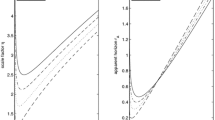Abstract
A new model is constructed for the Big Bang and the expansion of the Universe, based on a description of a spread of a finite mass of ideal (nonviscous and non-heat-conducting) gas from a point (“initial hot singularity”) to empty space in the framework of general and special relativity (GR and SR). That is, the expansion began inside the sphere with the gravitational radius of the Universe. At first sight, such a spread, like a spread of the singularity of a black hole, is impossible. However, a fundamental difference is that a black hole results from a collapse of a massive star after complete burning of its thermonuclear fuel. Therefore, although at a collapse the temperature, pressure and density grow infinitely, this growth is such that the gravitational forces in the course of compression are always larger than the resisting high pressure. Everything is the opposite at a spread of the initial hot singularity because of the huge (at the beginning of the spread) energy and pressure of all kinds of massless (with zero rest mass) and massive particles and antiparticles, under a negligible contribution of the excess (over antibaryons and positrons) baryons and electrons. In the process of spreading, the situation changes, and the energy of the atoms formed by these baryons and electrons becomes dominant.


Similar content being viewed by others
Change history
15 March 2022
An Erratum to this paper has been published: https://doi.org/10.1134/S0202289322010042
REFERENCES
G. C. McVittie, General Relativity and Cosmology (Chapman and Hall, London, 1956).
Kh. F. Valiyev and A. N. Kraiko, J. Appl. Math. Mech. 79, 237 (2015).
S. Perlmutter, http://www.nobelprize.org/nobel_prizes/physics/laureates/2011/perlmutter-lecture.html.
B. P. Schmidt, http://www.nobelprize.org/nobel_prizes/physics/laureates/2011/schmidt-lecture.html.
A. G. Riess, http://www.nobelprize.org/nobel_prizes/physics/laureates/2011/riess-lecture.html.
Kh. F. Valiyev and A. N. Kraiko, J. Appl. Math. Mech. 79, 556 (2015).
Kh. F. Valiev and A. N. Kraiko, Fluid Dynamics 53, 596 (2018).
Kh. F. Valiev and A. N. Kraiko, in: Proc. Int. Conf. XVII Khariton’s Topical Scientific Readings, Ed. A. L. Mikhailov (RFNC-VNIIEP, Sarov, 2015).
A. N. Kraiko and Kh. F. Valiyev, AIP Conf. Proc. 1770, 020002-1 (2016); in: Proc. 18th Int. Conf. on Methods of Aerophysical Research, Ed. V. Fomin (American Institute of Physics).
A. N. Kraiko and Kh. F. Valiyev, in: Proc. Int. Conf. XIX Khariton’s Topical Scientific Readings, Ed. A. L. Mikhailov (RFNC-VNIIEP, Sarov, 2017).
E. A. Milne, Relativity, Gravitation and World Structure (Clarendon Press, Oxford, 1935).
WMAP Cosmological Parameters Model/Data Set Matrix. NASA; http://lambda.gsfc.nasa.gov/product/map/current/parameters.cfm.
C. W. Misner, K. S. Thorne, and J. A. Wheeler, Gravitation. Vol. 2 (Freeman and Co., San Francisco, 1973).
S. Weinberg, The First Three Minutes (Basic Books, New York, 1977).
L. D. Landau and E. M. Lifshitz, The Classical Theory of Fields (Pergamon Press, New York, 1975).
K. A. Bronnikov and S. G. Rubin, Lectures on Gravitation and Cosmology (Moscow Engineering-Physics Institute, Moscow, 2008).
I. D. Novikov and V. P. Frolov, Physics of Black Holes (Nauka, Moscow, 1986).
I. S. Shikin, in: Mechanics. Modern Problems, Ed. G. G. Chernyi. (MSU, Moscow, 1987).
N. R. Sibgatullin, Dokl. Acad. Nauk SSSR 187, 531 (1969).
N. R. Sibgatullin, Oscillations and Waves in Strong Gravitational and Electromagnetic Fields (Nauka, Moscow, 1984).
Ya. B. Zel’dovich and I. D. Novikov, The Structure and Evolution of the Universe (Nauka, Moscow, 1975).
ACKNOWLEDGMENTS
The author is grateful to I.M. Vasenin and N.I. Tipliayeva for discussions, to Kh.F. Valiyev for helpful advice, to A.N. Golubiatnikov for consulting on GR, to K.A. Bronnikov for a discussion after which section 4 and the Conclusion were added, and to a referee for remarks whose complicated accounting has improved the paper.
Funding
The work has been carried out with support of Russian Basic Research Foundation project 20-01-00100.
Author information
Authors and Affiliations
Corresponding author
Rights and permissions
About this article
Cite this article
Kraiko, A.N. A Model of the Big Bang and Universe Expansion in General Relativity with Spread of a Gas Mass from a Point to Empty Space. Gravit. Cosmol. 26, 399–407 (2020). https://doi.org/10.1134/S0202289320040064
Received:
Revised:
Accepted:
Published:
Issue Date:
DOI: https://doi.org/10.1134/S0202289320040064



